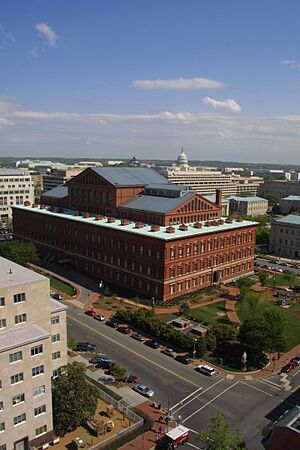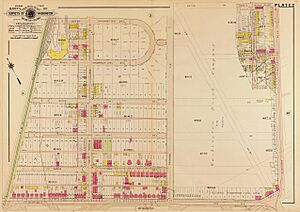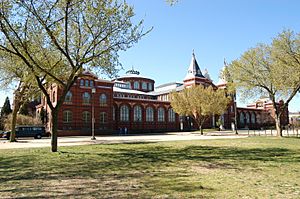Washington Brick Company facts for kids
|
Formerly
|
Washington Brick Machine Company |
|---|---|
| Public | |
| Industry | brick manufacturing |
| Founded | 1874 in Washington, D.C. |
| Headquarters | , |
|
Area served
|
Washington, D.C. |
| Products | red clay bricks |
|
Number of employees
|
23 factory employees (1874) |
The Washington Brick Machine Company was a company that made bricks in Washington, D.C. It started in 1874. The company used machines to make its bricks, which were used in many big buildings across the city. Some of these famous buildings are still standing today, like the Eisenhower Executive Office Building, the Arts and Industries Building, and the National Building Museum. In 1894, the company changed its name to the Washington Brick Company.
Contents
History of the Brick Company
How It All Started
The company officially started in 1874 and was first called the Washington Brick Machine Company. It was located in the northeast part of Washington, D.C. This company was special because it used machines to make bricks. Before this, most bricks were made by hand.
Using machines helped lower the cost of bricks. This was important after the Civil War, when Washington, D.C., was growing fast. Leaders like Alexander "Boss" Shepherd and William Dennison Jr. were working to modernize the city.
For its first ten years, the company won many large jobs with the United States government. They provided bricks for important new buildings.
- On September 14, 1876, the company won a contract to provide 1.5 million red bricks. These were for the east side of the State, War and Navy Building.
- On August 30, 1879, they won another contract. This time, it was to supply bricks for the National Museum. This building was designed by a famous architect named Adolf Cluss.
- On July 6, 1880, the company won the contract for the North Wing of the State, War and Navy Building. They had the lowest price for the bricks.
- On July 4, 1881, Edward Clark, who was the main architect for the U.S. Capitol, gave the company a contract. They were to provide bricks for an extension of the Government Printing Office. The price was $6.93 for every thousand bricks.
- On January 2, 1883, the company signed a big contract for the new Pension Office Building. This building is now the National Building Museum. They agreed to provide 600,000 special pressed bricks and 9 million regular bricks.
Buying Land and Building Homes
Starting in 1884, the company began to do more than just make bricks. They also started buying land to build homes. This is called real estate development.
On October 17, 1884, they bought a large piece of land called Trinidad. This land was about 150 acres and was located in northeast Washington, D.C. It had been owned by Columbian University (which is now George Washington University). The university sold the land for $100,000.
Later, on June 10, 1885, the company announced a new plan. They would build a new neighborhood of homes on a city block between 12th and 13th Street NE and H Street NE and I Street NE. They planned to build a new street called Wylie Street and make 105 building lots available. The company planned to build houses with 7 to 10 rooms, though most houses built were smaller.
On September 15, 1894, the company officially changed its name. It became the Washington Brick Company, dropping the word "Machine" from its name.
How the Company Operated
The main offices of the Washington Brick Company were located at 1420 New York Avenue NW.
The company's brick factory was in the northeast part of the city. It was near where Boundary Street (now Florida Avenue) meets H Street NE. This area is now known as the Trinidad neighborhood. The factory covered 10 acres of land, which was a rural area at the time.
Part of the company's property was used to dig up the fine clay needed to make bricks. This clay could be dug up to 40 feet deep. At the factory, there were sheds for drying bricks and a large building that held the engine and machine room. The company also had kilns, which are special ovens used to bake the bricks. They were also building new ovens to dry the bricks, so they didn't have to rely on sunny weather.
In 1874, the factory had 23 employees. They worked with a new machine that made brick manufacturing much faster. This machine was called Graham's patent. It was brought to Washington, D.C., by S. E. Henkins from the National Brick Machine Company in New Jersey. This machine could make between 40,000 and 60,000 bricks every day!
The machine was powered by a 40-horsepower engine. Workers would put loose clay and stones into a hopper. Four large rollers would crush the clay into a fine powder. This powder then went into a mixing cylinder, where it was steamed. After that, it moved into a vat. A conveyor belt with buckets would pick up just enough wet clay to form a brick. The wet clay would then drop into a mold and onto another conveyor belt. From there, workers would take the bricks to a drying room before they were baked in the kiln.
Important Buildings Made with Their Bricks
The Washington Brick Company's bricks were used in many important buildings in Washington, D.C.
- 1876: State, War and Navy Building (East Side), now known as the Eisenhower Executive Office Building.
- 1879: National Museum, now called the Arts and Industries Building, designed by Adolf Cluss.
- 1880: State, War and Navy Building (North Wing).
- 1881: Extension of the Government Printing Office Building.
- 1883: Pension Office Building, which is now the National Building Museum.




